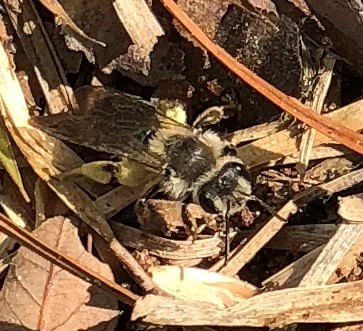
by Molly Jameson | Mar 26, 2018

Digger bees resemble honey bees, although they do not sting, and would only bite if mistreated. Photo by Molly Jameson.
Have you noticed many little dirt piles that resemble mini ant mounds around your yard? Well, fear not, for these mini mounds are made by digger bees who are excellent, yet ephemeral, early-spring pollinators.
These solitary ground-nesters are native to our area and only appear for four to six weeks to raise their offspring. Although they do not produce honey, they resemble honey bees in size and shape. They also do not sting and would only bite if they were handled roughly.
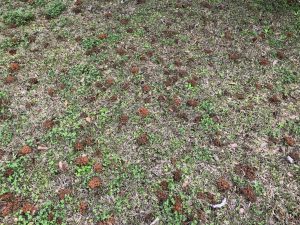
Female digger bees build their nests close together, creating clusters of many small mounds. Photo by Molly Jameson.
Otherwise known as miner bees, females create their underground cylinder-shaped nests in dry, well-drained soils, often right next to each other, creating patches of many mounds in a small area.
These bees will pollinate many early-spring blooming flowers – a bonus for gardeners – as they collect pollen to add to each cell that they excavate. They then lay their eggs on these pollen masses, cap the cells with clay, and complete their life cycles. The eggs hatch about five days later and emerge from the chamber created by their mothers.
While digger bee mounds may detract from an otherwise tidy lawn, they will do no harm, and can actually be beneficial, in that they improve air, water, and nutrient percolation. If you feel you must discourage their presence, simply run a sprinkler over the area as their season approaches. They prefer dry soil rather than wet soil and will look elsewhere to build their nests.
But better yet, take a seat on your front or back porch, pour yourself some lemonade, and take in the soothing hums of their wings as they do their work.
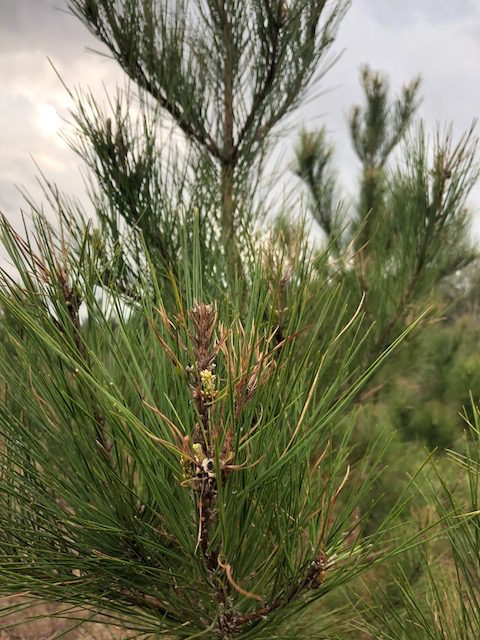
by Carrie Stevenson | Mar 26, 2018
Ah, the oft-ignored pine tree. They are so ubiquitous throughout the southeast, that many people consider them undesirable in a landscape. Having grown up near the “Pine Belt” of Mississippi, I figured I knew plenty about them, but this week I learned something new. While on a field tour with local foresters in the business of loblolly and longleaf pine farming, they introduced me to the pine tip moth. These insects can wreak havoc on valuable young pine trees.
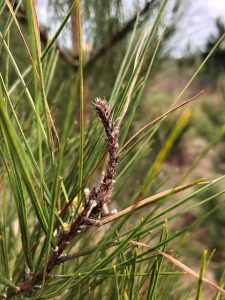
Dead branch tip and needle damage caused by pine tip moths. Photo credit: Carrie Stevenson, UF IFAS Extension
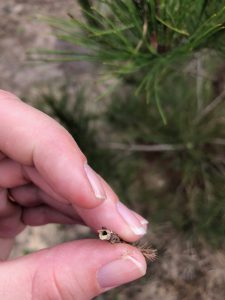
Hollow space in pine tree branch created by pine tip moth. Photo credit: Carrie Stevenson, UF IFAS Extension
Female pine tip moths lay eggs on the growing end of a pine branch—particularly young, healthy loblolly and shortleaf (longleaf is rarely affected). When the eggs hatch 5-30 days later, the larvae start feeding. They tunnel into the shoot and bud of the pines, feeding on the tissue and burrowing a hollow cavity for several weeks. The larvae then pupate inside the space until becoming adult moths, exiting from the hole they created. The cycle restarts, with more adult moths, eggs and larvae.
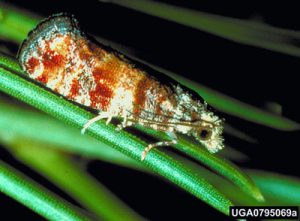
Adult Nantucket pine tip moth Rhyacionia frustrana (Comstock). Photograph by James A. Richmond, USDA Forest Service, www.Forestryimages.org.
Two insect species are most common in our area; the subtropical pine tip moth (Rhyacionia subtropica) and Nantucket pine tip moth (Rhyacionia frustrana). The moths are reddish copper in color, small (1/2” wingspan and 1/4” body length) and active at night. Caterpillar larvae have black heads and start out with off-white bodies, but change in color to brown and orange as they age.
While this insect activity typically does not kill the tree, it does cause some die-off of terminal needles and branches. In extreme cases, it can cause tree death. Moths prefer younger trees and rarely affect pines taller than 15 feet.
If you see a cluster of dead needles at the ends of young pine branches of your property, you can easily snap off the dead tip. You will likely find the hollow space formed by the larvae, which in spring may still contain the insect. Treatment in a home landscape can managed by hand removal of infested shoots, but those in the commercial forestry business may need to install traps and consider insecticidal management.
Visit the UF School of Forest Resources and Conservation website for more information.
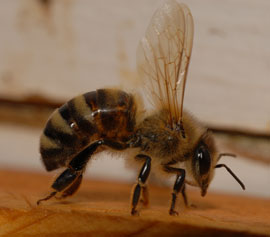
by Mary Salinas | Mar 21, 2018

European honey bee. Photo credit: UF/IFAS.
Bees, butterflies and other insects play important roles as pollinators in our environment. Over 50 major crops in the United States and at least 13 crops in Florida depend on honey bees. Many native plants in natural areas also depend on insect pollinators for reproduction. In Florida, over 300 bee species play a role in pollination!
Many factors affect the health of our pollinators. One of those factors we can easily control in our own landscapes is exposures to pesticides. How are bees and other pollinators exposed to pesticides? Here are some of the major routes:
- Drift of pesticides sprayed in breezy/windy conditions
- The erosion of contaminated topsoil blowing in the wind
- Direct feeding on pollen and nectar of treated plants
- Contact with pesticides that have blown onto plant surfaces
- Contact with water transpired by leaves of treated plants
- Pesticides that move down through the soil to affect ground dwelling bees and other insects
Did you know that bees become statically charged when they fly causing particles in the air to attract to them?
What are some ways that we can reduce the risk of exposure to pollinators in our landscapes?
- Use integrated pest management principles to reduce the incidence of pests and their impacts.
- Avoid treating areas containing flowering weeds/plants with insecticides. If you must treat your lawn with an insecticide, and it contains flowering weeds, mow the lawn and remove the flowers just before applying the insecticide.
- If you must apply a systemic insecticide to your lawn, leave a buffer strip of several feet between the lawn and the border of landscape beds with flowering plants. This will prevent the flowering plants from up taking the systemic product.
- Postpone any insecticide treatment until after all blooms have fallen from flowering ornamentals. Never apply an insecticide to blooms or flowering plants.
- Avoid the use of neonicotinoids as this class of insecticides can be more toxic to bees than other classes of insecticides. There are many effective alternatives.
Bee friendly to our pollinators!
For more information:
Minimizing Honey Bee Exposure to Pesticides
Creating and Maintaining Healthy Pollinator Habitat – Xerces Society
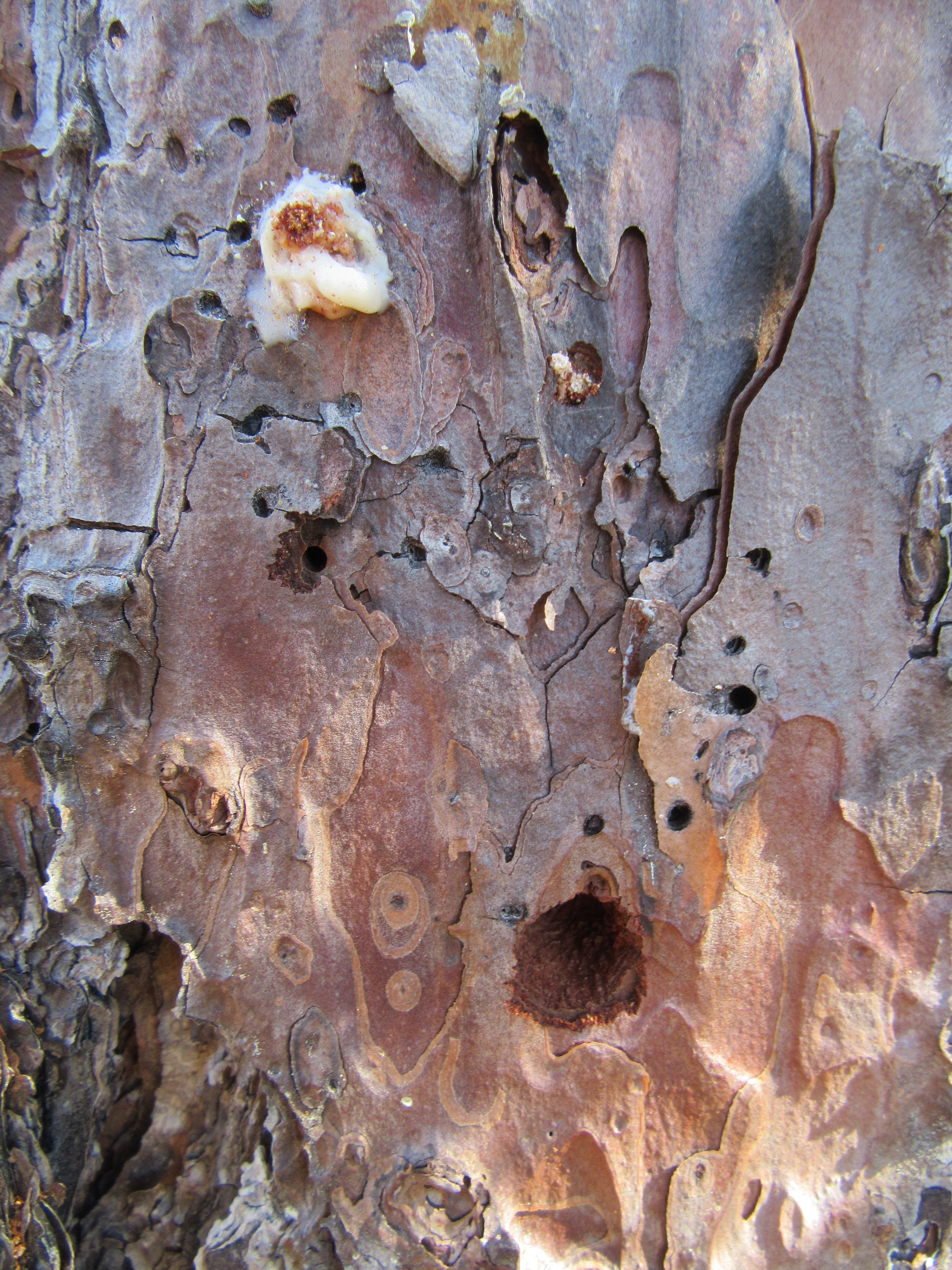
by Matt Lollar | Nov 20, 2017
Sometimes you don’t realize a tree is dying until it is dead. A few weeks ago, we got a call from a client who said he had insects killing his trees. Before having someone drive out to the property, our Master Gardener volunteer recommended that the client bring in some of the insects for us to take a look. It turned out the insects invading his pine tree were a type of longhorned beetle, but more specimens were required for identification. A site visit soon ensued.
There were a number of pine trees on the property, however only one was infested with the insects in question. Upon closer investigation, we noticed a number of different sized holes in the tree. The larger holes are nearly the size of a dime.
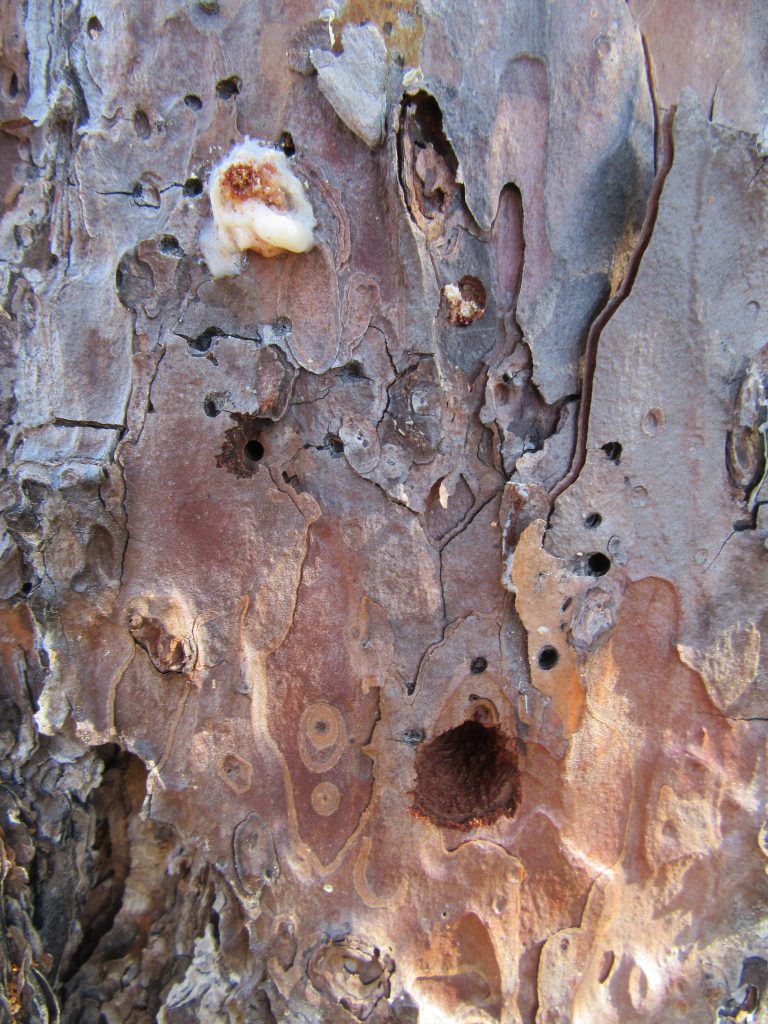
Arrowhead borer damage on a pine tree. Photo Credit: University of Florida/IFAS Extension.
It turns out the insects making the larger holes are a type of longhorned beetle known as an arrowhead borer (Xylotrechus sagittatus). The borers are brown to black in color with a reddish hue. They are moderately hairy and some specimens contain arrowhead markings pointing toward their heads. Adults feed on the bark of damaged or fire-killed pines. The adults are attracted to lights and may be mistaken for crickets because they run very fast. Eggs are laid in bark and larvae feed on sapwood, then tunnel deeper, often tunneling within a single annual ring. The borers pupate inside the tree and the newly emerged adults chew their way out.
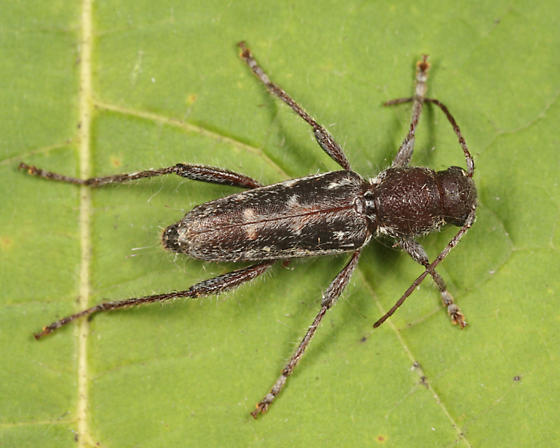
Arrowhead Borer. Photo Credit: Tom Murray bugguide.net.
Given the fact that arrowhead borers are attracted to dead or dying trees, the killer of this particular tree is still in question. The smaller holes in the bark picture above were created by a much smaller beetle, but we were unable to get a specimen. We did see a couple of these beetles running around when we dug deeper into the bark. The small beetles that we saw closely resembled a type of Ips engraver beetle. Beetles in this genus have been known to kill trees, but most likely they weren’t the culprits either. Based on the overall appearance of the tree and the fact that other trees in the area were not infested with beetles, it is believed the tree was killed by other means. The tree was likely struck by lightening or suffered from poor genetics because it did not have a good form for a pine tree.
If you have a questionable looking tree on your property or if you have insects you would like identified, please feel free to stop by your local Extension Office and ask a Master Gardener!

by Molly Jameson | Nov 13, 2017

Take lessons from a farmer to control fire ants in your garden. Photo by Molly Jameson.
As I near the three-year mark of being an Extension Agent, I think about how fortunate I am to have a career that not only encourages me to meet all our local farmers, but also to learn from them and share their knowledge with the community.
A few months ago, I visited Blake Canter of Owen River Farm. Blake gave me the grand tour of his small mixed vegetable plot, which is in far east Tallahassee.
One thing that I remember most about my visit with Blake was what has worked for him in controlling the notorious red imported fire ant (Solenopsis invicta). I have heard of many different ways to control these non-native invaders, each with its drawbacks, and, it seems, anecdotally limited success.
For instance, spinosad, a nervous system toxin, has been known to be effective on fire ant populations and is considered safe to use in vegetable gardens. But in practice, I have heard mixed reviews. In my home garden, I either douse the mounds with boiling water (be careful!) or leave my garden hose in the hot sun and scorch them while the water is still hot. But often, I signal defeat, letting them take captive of two corners of my raised beds.
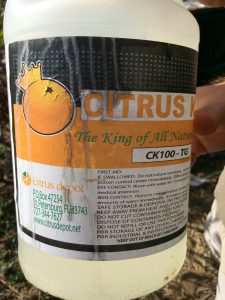
Blake at Owen River Farm makes his fire ant control mixture by combining commercial grade d-Limonene and a hefty squirt of eco-friendly dish soap into five gallons of water. Photo by Molly Jameson.
Blake’s technique on Owen River Farm is using commercial grade d-Limonene, which is a distilled orange oil nerve toxin. Blake mixes one-third cup of d-Limonene with a hefty squirt of eco-friendly dish soap in a five-gallon bucket of water. He then uses this mixture as a drench for fire ant mounds – which he figures is about as effective as boiling water – but much safer and easier to handle (be sure to follow the label carefully when using any product).
Blake goes out early in the morning (when fire ants move slower and queens are usually higher in their nests) and pours the mixture onto the mounds in a spiral formation, from outside in, to minimize escape. He tries to collapse the mound as much as possible, while pouring slowly so it penetrates deeply, with minimal runoff.
Depending on colony size, Blake uses about half the bucket, or more, on just one mound. He warns that he has lost a cucumber plant that was about a foot away to this method, but he knows the ants will often do even more damage, if not sting and bite (they do both!) him hundreds of times, as he works in his vegetable beds.
Blake likes this method because, “I can specifically target the fire ants, and after doing its job, the all-natural orange oil quickly becomes inert. When I used organic ant bait I found that the native ants took up the poison, often times faster than the fire ants. This was particularly bad because native ants are the number one competition for fire ants.”
Blake also points out, “Make sure anyone you recommend this to can identify the difference between fire ant mounds with no center opening to the mound, and native ant mounds, where there is usually an entrance hole in the center of the mound.”
The hardest part, Blake says, is finding the queens. For instance, he says ants often make auxiliary mounds at the base of okra plants, but this is not where the queen resides. The queen will often be in a central mound many yards away from where her workers are foraging. And, unfortunately, these worker ants love easily habitable soft soil, just like in our raised bed vegetable gardens.
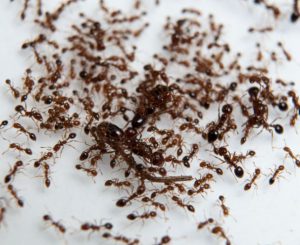
Fire ants in a petri dish. Photo by UF/IFAS.
Despite these challenges, last fall Blake drenched colonies whenever he found a mound around his farm (sometimes daily), and after a few weeks he noticed a drastic reduction in fire ant populations. And happily, an increased population of harmless (and even helpful!) native black ants. His brassica (think kale, collards, broccoli, cabbages) transplants were no longer getting girdled by vicious fire ants and he was no longer ending up with dozens of ant bites every time he worked in his beds!
Blake does warn that you must stay vigilant, especially in the summer and fall and after rain events, when the ants become busy building new colonies.
Lastly, Blake also uses his orange oil mixture as a spray for contact killing ants and other garden pests. However, just as with all horticultural oils and soaps (often made from plant oils, animal fats, or petroleum), care must be taken not to burn the foliage of your crops. Blake will sometimes dilute his mixture for this purpose. But just remember, to really stop an ant infestation, you must take down the queen!
For more information on least-toxic garden pest control strategies, read the UF/IFAS EDIS publication “Natural Products for Managing Landscape and Garden Pests in Florida” available at: https://edis.ifas.ufl.edu/in197.
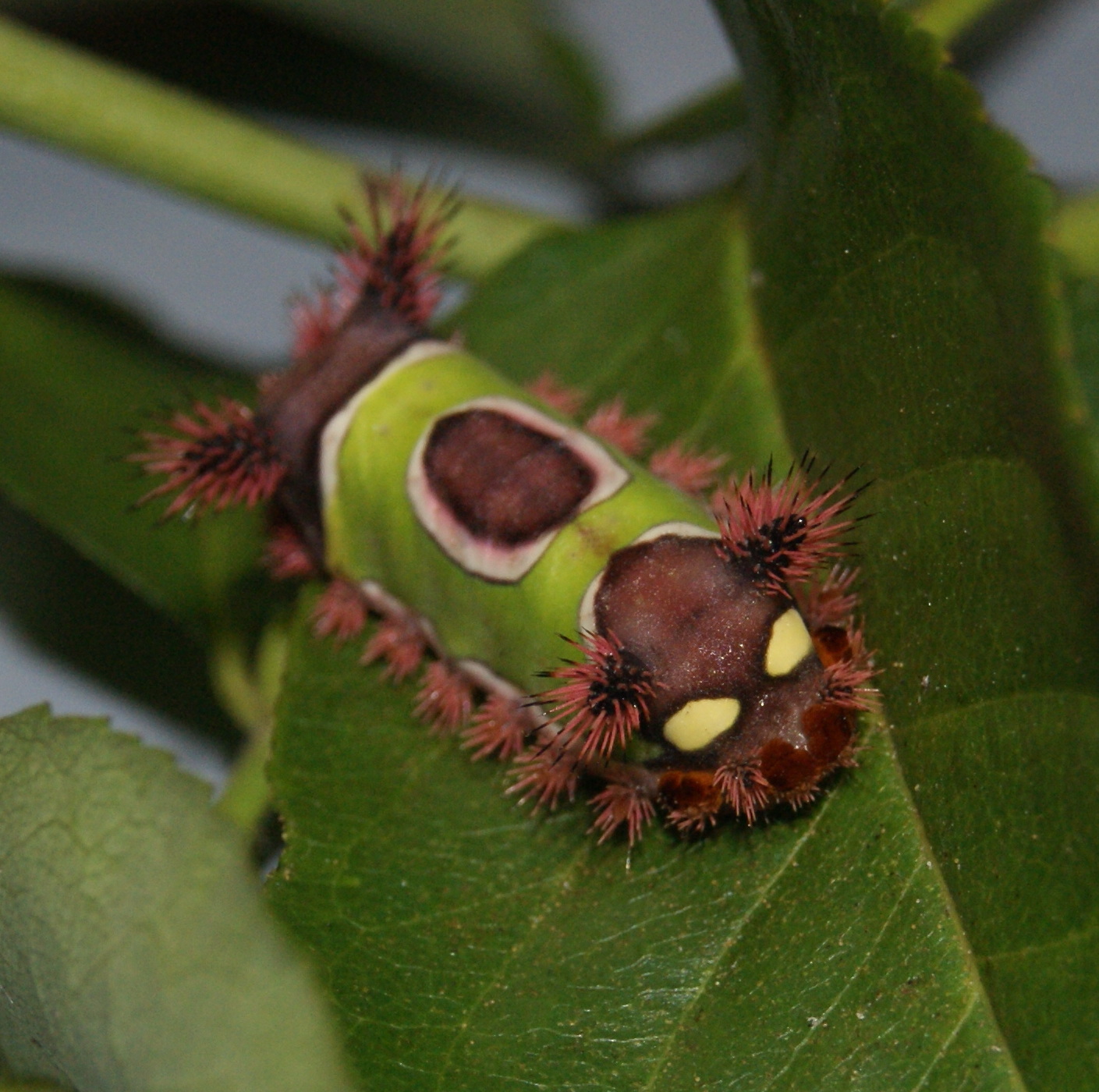
by Larry Williams | Nov 6, 2017
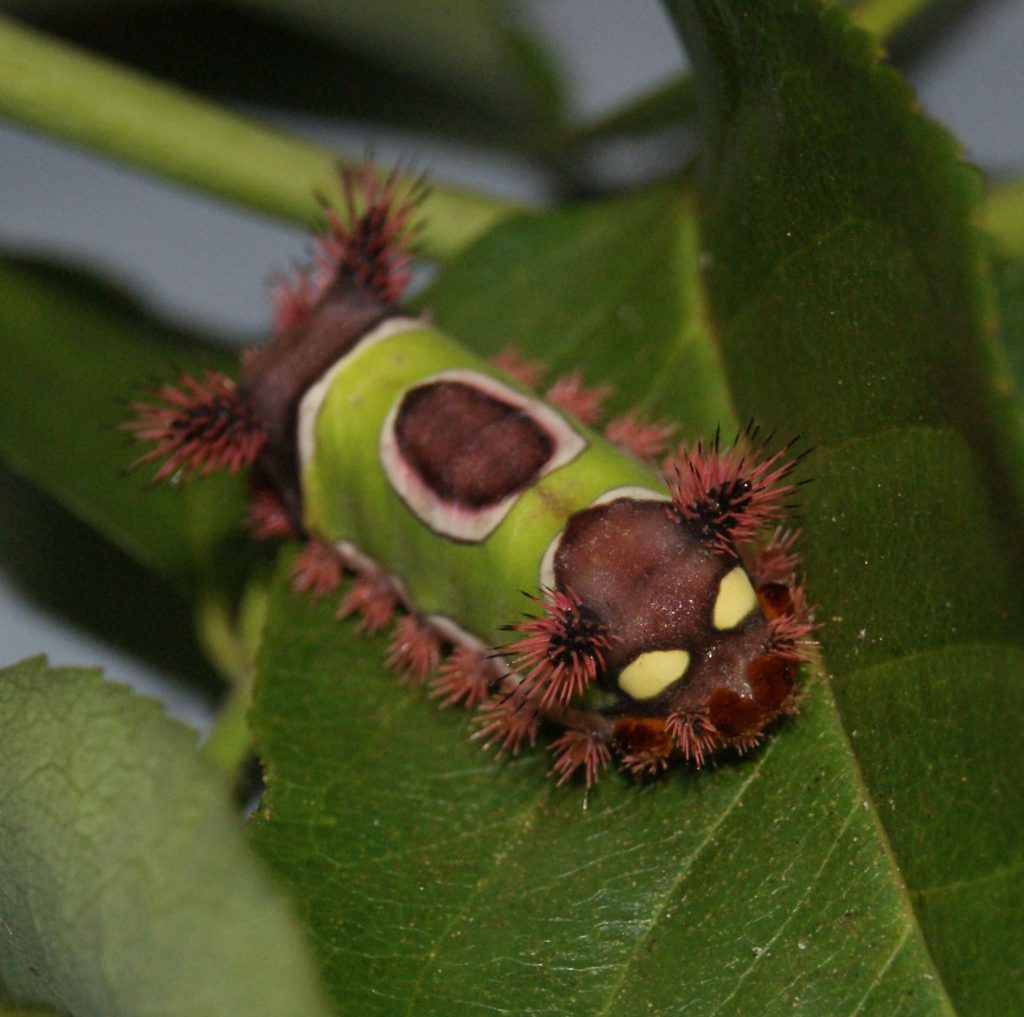
Saddleback Caterpillar. Image Credit: Matthew Orwat UF / IFAS
Did you know we have caterpillars that sting here in Northwest Florida? Well, we do and you’d be wise to learn about them and how to recognize them.
These caterpillars do not sting in the same way that a wasp or bee might sting. They do not have “stingers.” But they do have spines, also called nettling hairs, which are connected to poison glands that can inflict a painful reaction if touched.
The four nettling caterpillars that you are more likely to encounter in Florida are the hag caterpillar, Io moth caterpillar, puss caterpillar and saddleback caterpillar. Those that you are less likely to come in contact with include the buck moth caterpillar, flannel moth caterpillar, spiny oak-slug caterpillar and tussock moth caterpillar.
The “sting” is unintentional, not deliberate. When brushed against or touched, the toxin-bearing spines break off, releasing toxins. In some cases, broken spines pierce the skin. In other cases, toxins leak out onto the surface of the skin.
A University of Florida-IFAS Extension publication about these caterpillars states, “Some people experience severe reactions to the poison released by the spines and require medical attention. Others experience only an itching or burning sensation.”
The kind of reaction can depend on the type of caterpillar, extent of contact and susceptibility of individual. Fortunately, most of these caterpillars spend most of their time high up in trees away from us. But they can blow out of the trees during windy weather or come down still attached to branches and limbs that fall.
The saddleback caterpillar is more likely to be encountered because it feeds on many of our common landscape plants such as hibiscus and palms. But it is also known to feed on azaleas, fruit trees and even canna lilies. The saddleback caterpillar is striking in appearance with what looks like a bright green “blanket” draped over its back and a brown saddle-shaped oval area in the center of the blanket. Its spines are colorful, sharp and protrude from the front, back and sides of the caterpillar. It is stout and 1 to 1.5 inches long.
I’ve received questions about the puss caterpillar recently from people who have encountered it. This caterpillar is stout-bodied, almost 1 inch long and completely covered with gray to brown soft hairs. They seem to prefer leaves of oaks and citrus but they will feed on a variety of broadleaf trees and shrubs,
Because of their bright colors and interesting appearance, children may be tempted to touch or pick up some of these stinging caterpillars.
More information on these caterpillars is available at these websites:
http://edis.ifas.ufl.edu/pdffiles/IN/IN01400.pdf
http://www.poisoncentertampa.org/poison-topics/venomous-critters/caterpillars
















